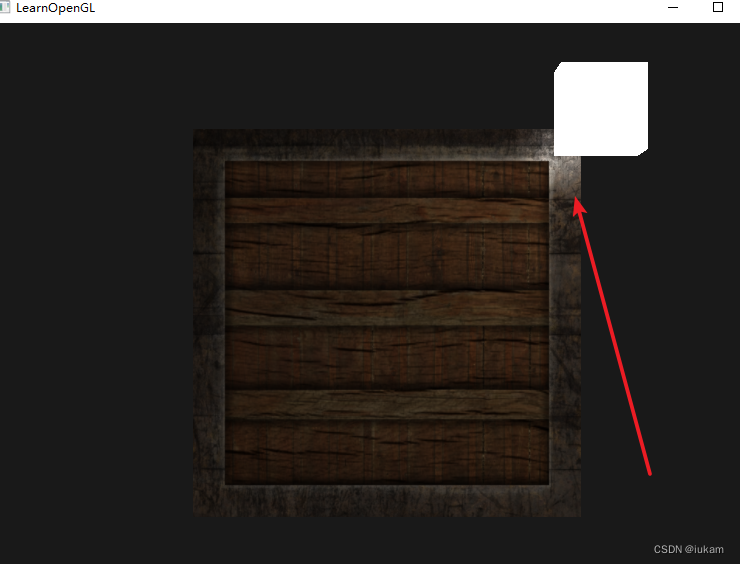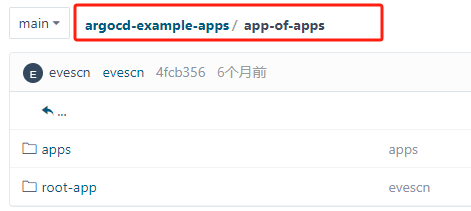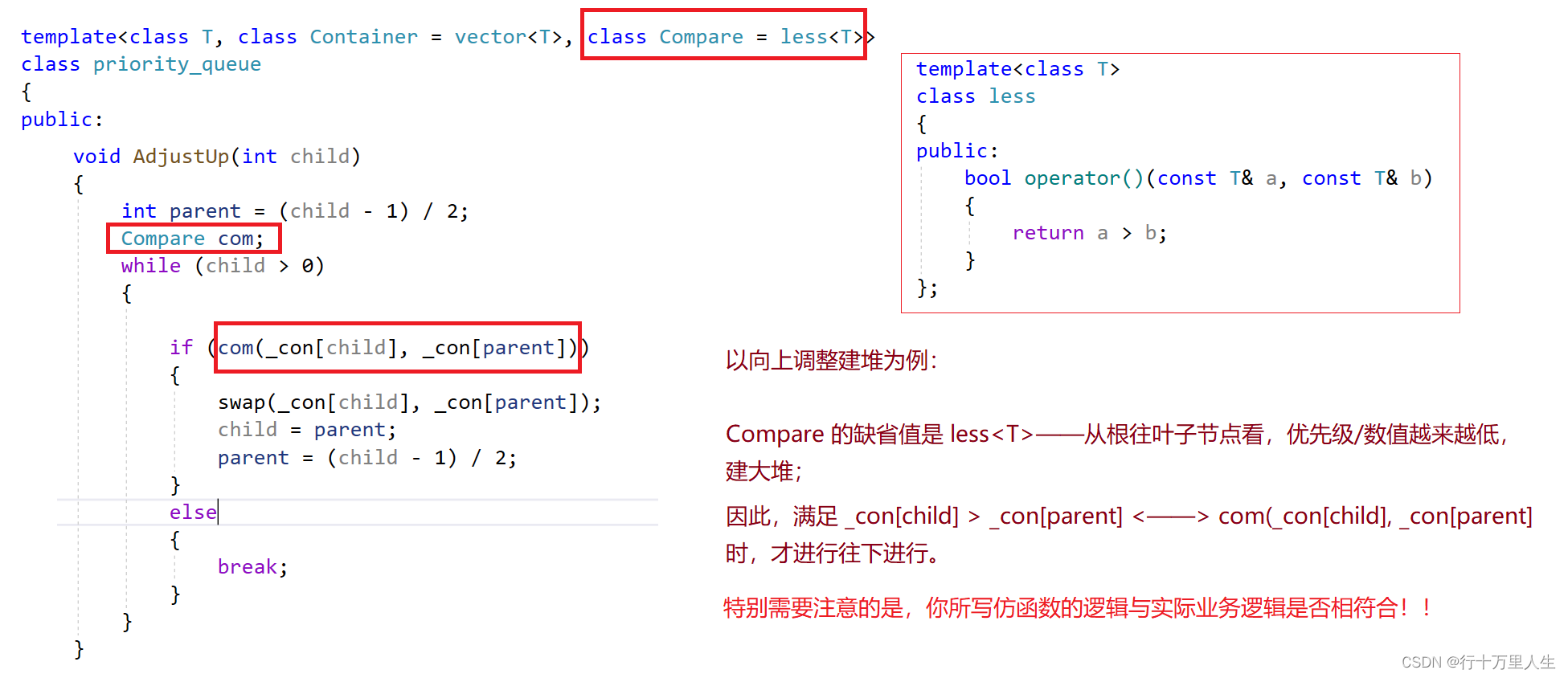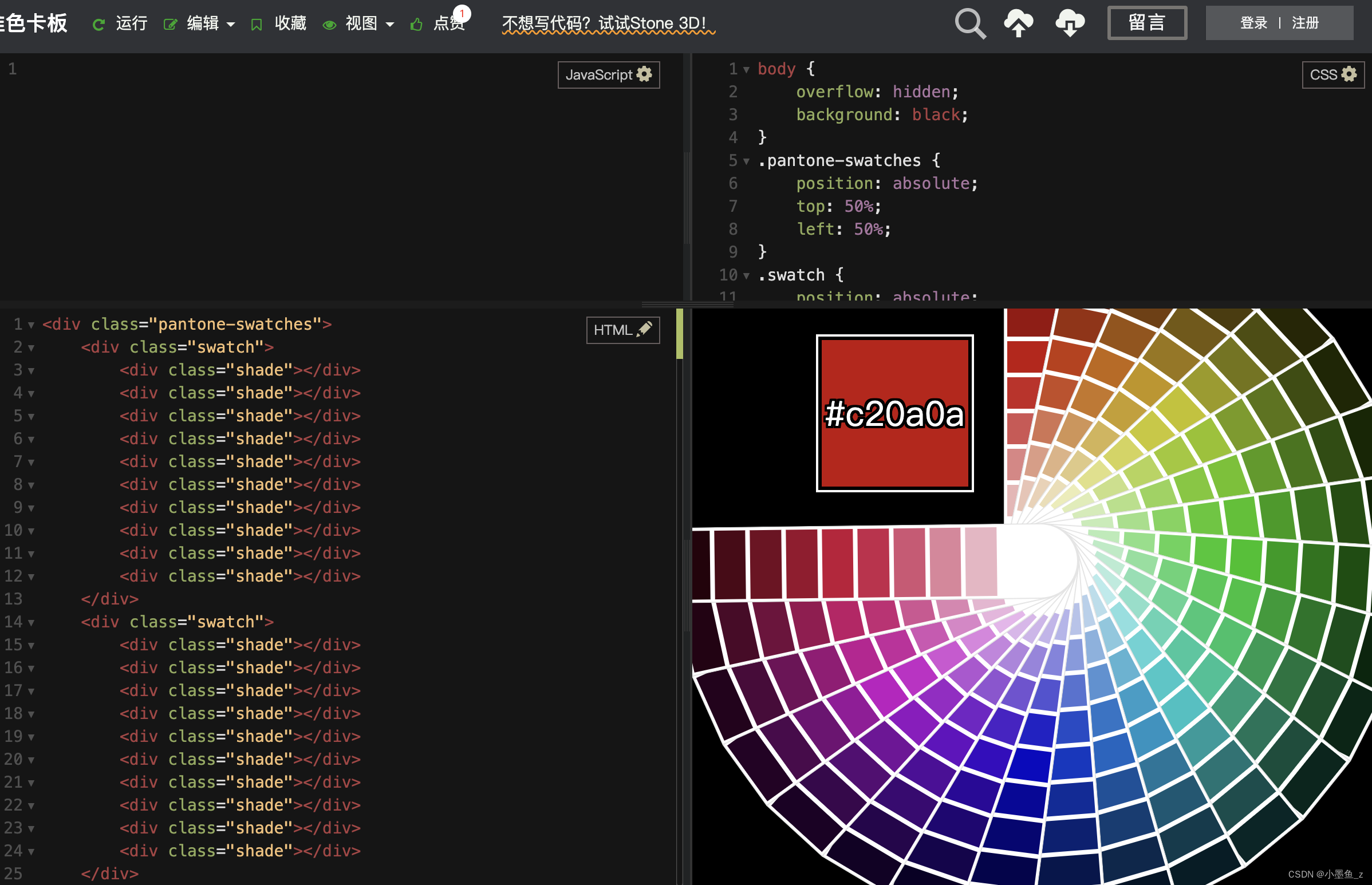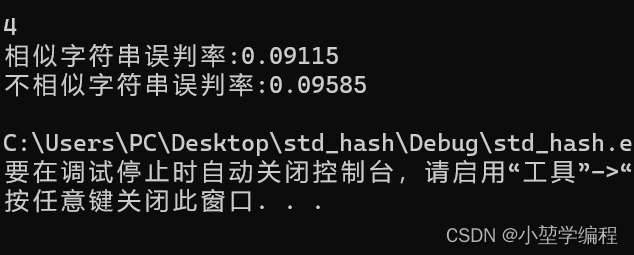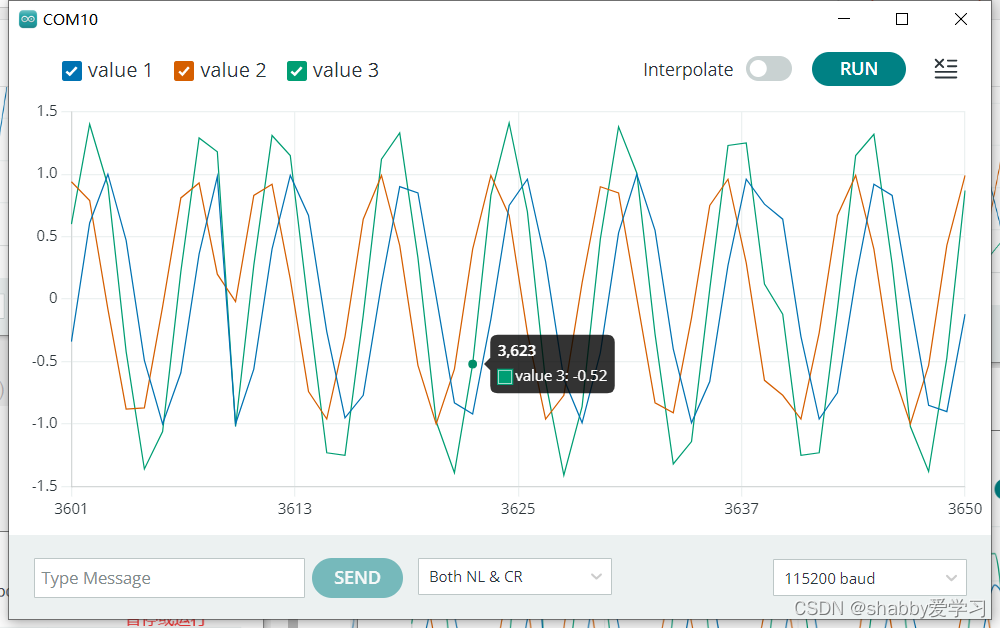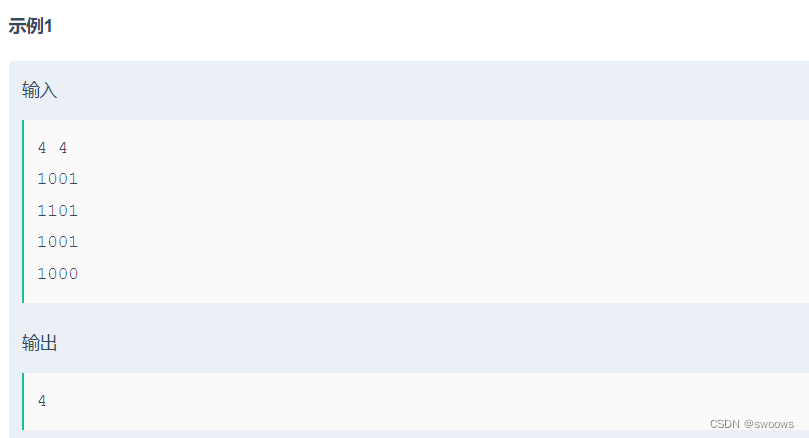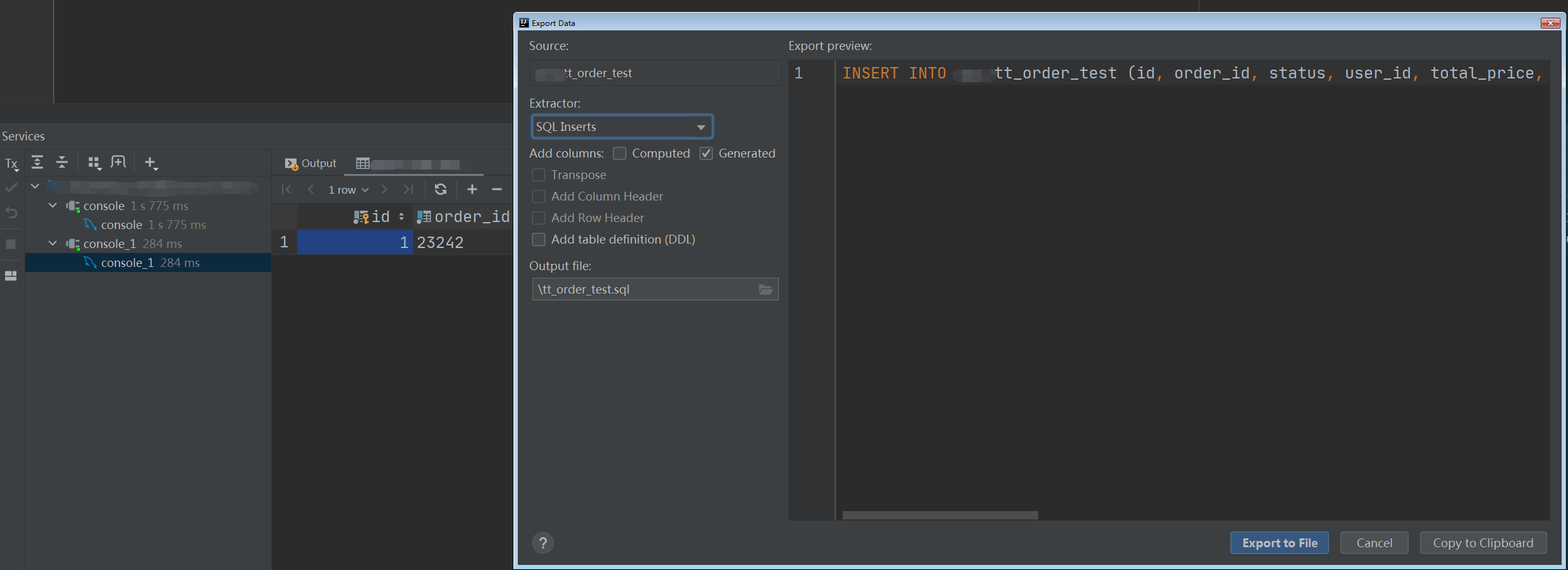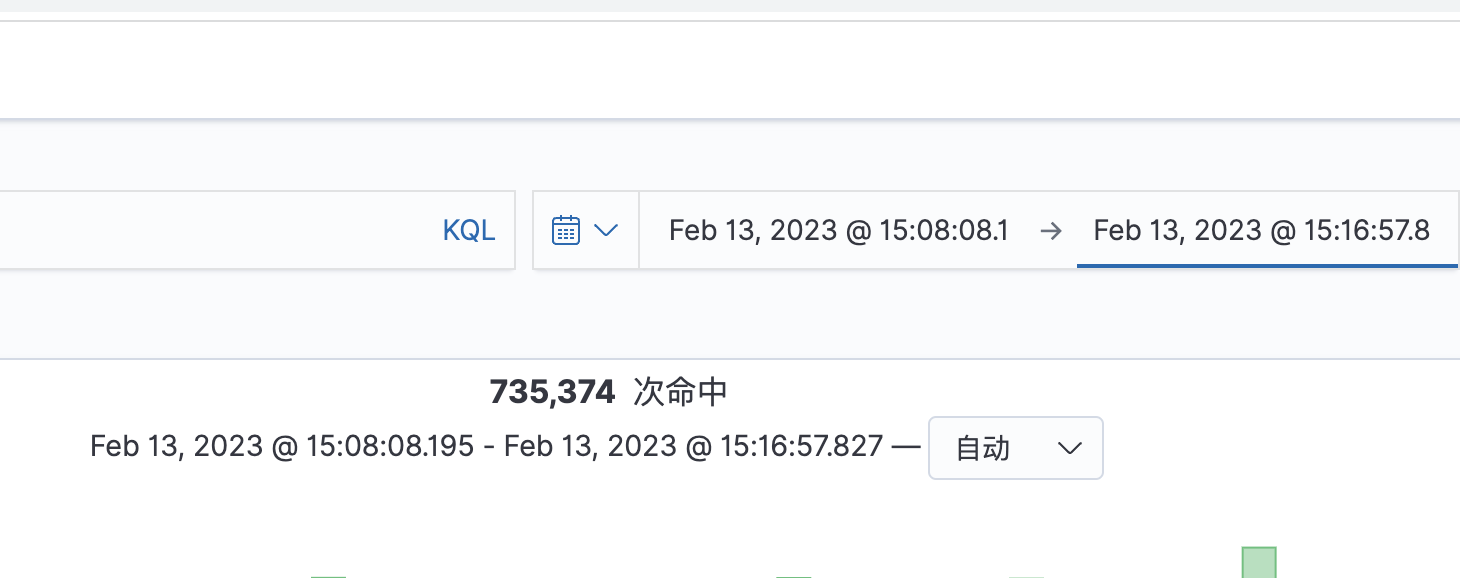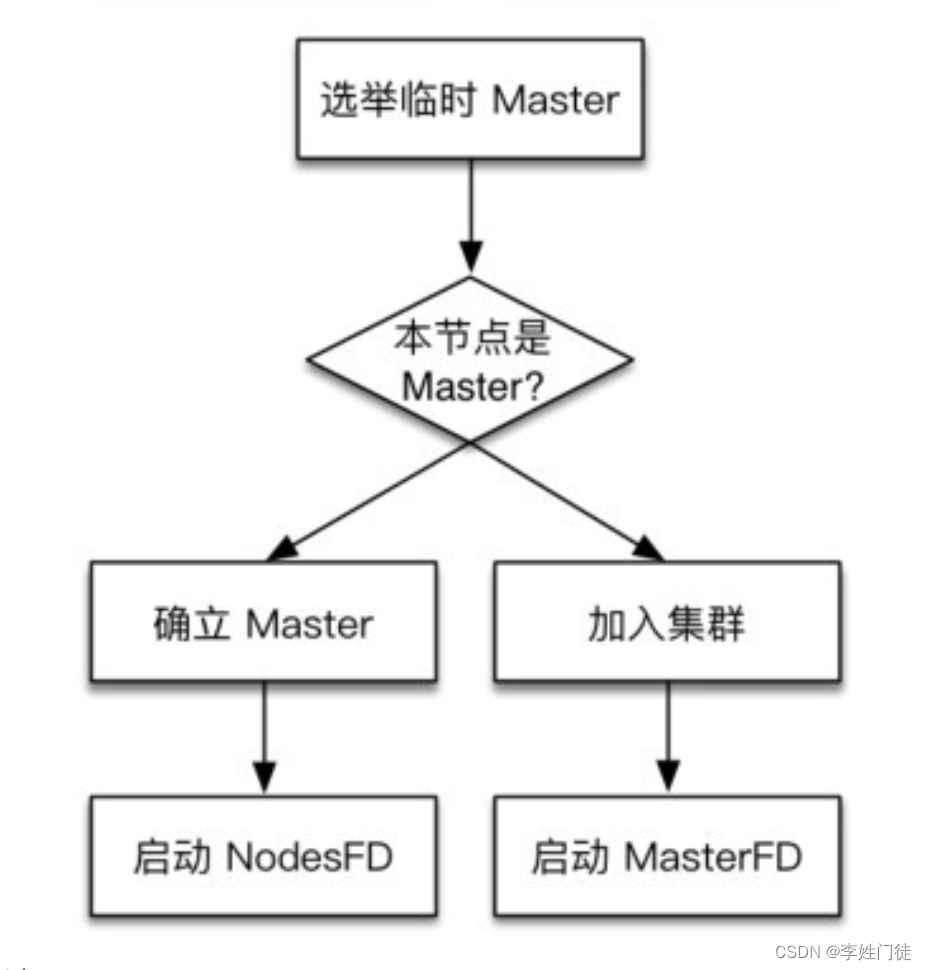文章目录
- 材质
- 设置材质
- 光的属性
- 脚本实现
- 光照贴图
- 漫反射贴图
- 高光反射贴图
材质
材质本质是一个数据集,主要功能就是给渲染器提供数据和光照算法。
如果我们想要在OpenGL中模拟多种类型的物体,我们必须针对每种表面定义不同的材质(Material)属性。
我们可以分别为三个光照分量定义一个材质颜色(Material Color):环境光照(Ambient Lighting)、漫反射光照(Diffuse Lighting)和镜面光照(Specular Lighting)。通过为每个分量指定一个颜色,我们就能够对表面的颜色输出有细粒度的控制了。
再添加一个反光度(Shininess)分量,设置材质属性:
#version 330 core
struct Material {
vec3 ambient;
vec3 diffuse;
vec3 specular;
float shininess;
};
//在片段着色器中,我们创建一个结构体(Struct)来储存物体的材质属性。
uniform Material material;
设置材质
可以通过设置适当的uniform来设置应用中物体。
GLSL中一个结构体在设置uniform时并无任何区别,结构体只是充当uniform变量们的一个命名空间。所以如果想填充这个结构体的话,我们必须设置每个单独的uniform,但要以结构体名为前缀:
lightingShader.setVec3("material.ambient", 1.0f, 0.5f, 0.31f);
lightingShader.setVec3("material.diffuse", 1.0f, 0.5f, 0.31f);
lightingShader.setVec3("material.specular", 0.5f, 0.5f, 0.5f);
lightingShader.setFloat("material.shininess", 32.0f);
光的属性
一个光源对它的ambient、diffuse和specular光照分量有着不同的强度。
- 环境光照通常被设置为一个比较低的强度,因为我们不希望环境光颜色太过主导。
- 光源的漫反射分量通常被设置为我们希望光所具有的那个颜色,通常是一个比较明亮的白色。
- 镜面光分量通常会保持为vec3(1.0),以最大强度发光。注意我们也将光源的位置向量加入了结构体。
为光照属性创建类似材质结构体:
struct Light {
vec3 position;
vec3 ambient;
vec3 diffuse;
vec3 specular;
};
uniform Light light;
和材质uniform一样,我们需要更新片段着色器:
vec3 ambient = light.ambient * material.ambient;
vec3 diffuse = light.diffuse * (diff * material.diffuse);
vec3 specular = light.specular * (spec * material.specular);
脚本实现
创建材质的顶点着色器和片元着色器
materials.vs
#version 330 core
layout (location = 0) in vec3 aPos;
layout (location = 1) in vec3 aNormal;
out vec3 FragPos;
out vec3 Normal;
uniform mat4 model;
uniform mat4 view;
uniform mat4 projection;
void main()
{
FragPos = vec3(model * vec4(aPos, 1.0));
//在顶点着色器中,我们可以使用inverse和transpose函数自己生成这个法线矩阵,这两个函数对所有类型矩阵都有效
Normal = mat3(transpose(inverse(model))) * aNormal;
gl_Position = projection * view * vec4(FragPos, 1.0);
}
materials.fs
#version 330 core
out vec4 FragColor;
struct Material {
vec3 ambient;
vec3 diffuse;
vec3 specular;
float shininess;
};
struct Light {
vec3 position;
vec3 ambient;
vec3 diffuse;
vec3 specular;
};
in vec3 FragPos;
in vec3 Normal;
uniform vec3 viewPos;
uniform Material material;
uniform Light light;
void main()
{
// ambient
vec3 ambient = light.ambient * material.ambient;
// diffuse
vec3 norm = normalize(Normal);
vec3 lightDir = normalize(light.position - FragPos);
float diff = max(dot(norm, lightDir), 0.0);
vec3 diffuse = light.diffuse * (diff * material.diffuse);
// specular
vec3 viewDir = normalize(viewPos - FragPos);
vec3 reflectDir = reflect(-lightDir, norm);
float spec = pow(max(dot(viewDir, reflectDir), 0.0), material.shininess);
vec3 specular = light.specular * (spec * material.specular);
vec3 result = ambient + diffuse + specular;
FragColor = vec4(result, 1.0);
}
创建灯光的顶点着色器和片元着色器
light_mrt_cube.vs
#version 330 core
layout (location = 0) in vec3 aPos;
uniform mat4 model;
uniform mat4 view;
uniform mat4 projection;
void main()
{
gl_Position = projection * view * model * vec4(aPos, 1.0);
}
light_mrt_cube.fs
#version 330 core
out vec4 FragColor;
void main()
{
FragColor = vec4(1.0); // set all 4 vector values to 1.0
}

完整源码
#include <glad/glad.h>
#include <GLFW/glfw3.h>
#include <glm/glm.hpp>
#include <glm/gtc/matrix_transform.hpp>
#include <glm/gtc/type_ptr.hpp>
#define STB_IMAGE_IMPLEMENTATION
#include <stb_image.h>
// https://learnopengl.com/code_viewer_gh.php?code=includes/learnopengl/shader_m.h
#include <shader_s.h>
// https://learnopengl.com/code_viewer_gh.php?code=includes/learnopengl/camera.h
#include <camera.h>
void InitGLFW();
bool CreateWindow();
bool InitGLAD();
// 窗口大小改变时调用
void framebuffer_size_callback(GLFWwindow *window, int width, int height);
void mouse_callback(GLFWwindow *window, double xposIn, double yposIn);
void scroll_callback(GLFWwindow *window, double xoffset, double yoffset);
void processInput(GLFWwindow *window);
// settings 窗口宽高
const unsigned int SCR_WIDTH = 800;
const unsigned int SCR_HEIGHT = 600;
// 相机
Camera camera(glm::vec3(0.0f, 0.0f, 6.0f));
float lastX = static_cast<float>(SCR_WIDTH) / 2.0;
float lastY = static_cast<float>(SCR_HEIGHT) / 2.0;
bool firstMouse = true;
// timing
float deltaTime = 0.0f; // time between current frame and last frame
float lastFrame = 0.0f;
// lighting
glm::vec3 lightPos(0.5f, 0.5f, 1.0f);
GLFWwindow *window;
int main()
{
InitGLFW(); // 初始化GLFW
bool isCreated = CreateWindow(); // 创建一个窗口对象
if (!isCreated)
return -1;
bool isGLAD = InitGLAD(); // 初始化GLAD,传入加载系统相关opengl函数指针的函数
if (!isGLAD)
return -1;
// 启用深度测试
glEnable(GL_DEPTH_TEST);
// 构建和编译着色程序
Shader lightingShader("shader/P1_Basic/08_LightModel/materials.vs", "shader/P1_Basic/08_LightModel/materials.fs");
Shader lightCubeShader("shader/P1_Basic/08_LightModel/light_mrt_cube.vs", "shader/P1_Basic/08_LightModel/light_mrt_cube.fs");
// 设置顶点数据(和缓冲区)并配置顶点属性
// 1.设置立方体顶点输入 一共需要36个顶点
float vertices[] = {
-0.5f, -0.5f, -0.5f, 0.0f, 0.0f, -1.0f,
0.5f, -0.5f, -0.5f, 0.0f, 0.0f, -1.0f,
0.5f, 0.5f, -0.5f, 0.0f, 0.0f, -1.0f,
0.5f, 0.5f, -0.5f, 0.0f, 0.0f, -1.0f,
-0.5f, 0.5f, -0.5f, 0.0f, 0.0f, -1.0f,
-0.5f, -0.5f, -0.5f, 0.0f, 0.0f, -1.0f,
-0.5f, -0.5f, 0.5f, 0.0f, 0.0f, 1.0f,
0.5f, -0.5f, 0.5f, 0.0f, 0.0f, 1.0f,
0.5f, 0.5f, 0.5f, 0.0f, 0.0f, 1.0f,
0.5f, 0.5f, 0.5f, 0.0f, 0.0f, 1.0f,
-0.5f, 0.5f, 0.5f, 0.0f, 0.0f, 1.0f,
-0.5f, -0.5f, 0.5f, 0.0f, 0.0f, 1.0f,
-0.5f, 0.5f, 0.5f, -1.0f, 0.0f, 0.0f,
-0.5f, 0.5f, -0.5f, -1.0f, 0.0f, 0.0f,
-0.5f, -0.5f, -0.5f, -1.0f, 0.0f, 0.0f,
-0.5f, -0.5f, -0.5f, -1.0f, 0.0f, 0.0f,
-0.5f, -0.5f, 0.5f, -1.0f, 0.0f, 0.0f,
-0.5f, 0.5f, 0.5f, -1.0f, 0.0f, 0.0f,
0.5f, 0.5f, 0.5f, 1.0f, 0.0f, 0.0f,
0.5f, 0.5f, -0.5f, 1.0f, 0.0f, 0.0f,
0.5f, -0.5f, -0.5f, 1.0f, 0.0f, 0.0f,
0.5f, -0.5f, -0.5f, 1.0f, 0.0f, 0.0f,
0.5f, -0.5f, 0.5f, 1.0f, 0.0f, 0.0f,
0.5f, 0.5f, 0.5f, 1.0f, 0.0f, 0.0f,
-0.5f, -0.5f, -0.5f, 0.0f, -1.0f, 0.0f,
0.5f, -0.5f, -0.5f, 0.0f, -1.0f, 0.0f,
0.5f, -0.5f, 0.5f, 0.0f, -1.0f, 0.0f,
0.5f, -0.5f, 0.5f, 0.0f, -1.0f, 0.0f,
-0.5f, -0.5f, 0.5f, 0.0f, -1.0f, 0.0f,
-0.5f, -0.5f, -0.5f, 0.0f, -1.0f, 0.0f,
-0.5f, 0.5f, -0.5f, 0.0f, 1.0f, 0.0f,
0.5f, 0.5f, -0.5f, 0.0f, 1.0f, 0.0f,
0.5f, 0.5f, 0.5f, 0.0f, 1.0f, 0.0f,
0.5f, 0.5f, 0.5f, 0.0f, 1.0f, 0.0f,
-0.5f, 0.5f, 0.5f, 0.0f, 1.0f, 0.0f,
-0.5f, 0.5f, -0.5f, 0.0f, 1.0f, 0.0f
};
// 2.设置索引缓冲对象
unsigned int VBO, cubeVAO;
glGenVertexArrays(1, &cubeVAO);
glGenBuffers(1, &VBO);
glBindBuffer(GL_ARRAY_BUFFER, VBO);
glBufferData(GL_ARRAY_BUFFER, sizeof(vertices), vertices, GL_STATIC_DRAW);
glBindVertexArray(cubeVAO);
// position attribute
glVertexAttribPointer(0, 3, GL_FLOAT, GL_FALSE, 6 * sizeof(float), (void*)0);
glEnableVertexAttribArray(0);
// normal attribute
glVertexAttribPointer(1, 3, GL_FLOAT, GL_FALSE, 6 * sizeof(float), (void*)(3 * sizeof(float)));
glEnableVertexAttribArray(1);
// second, configure the light's VAO (VBO stays the same; the vertices are the same for the light object which is also a 3D cube)
unsigned int lightCubeVAO;
glGenVertexArrays(1, &lightCubeVAO);
glBindVertexArray(lightCubeVAO);
glBindBuffer(GL_ARRAY_BUFFER, VBO);
// note that we update the lamp's position attribute's stride to reflect the updated buffer data
glVertexAttribPointer(0, 3, GL_FLOAT, GL_FALSE, 6 * sizeof(float), (void*)0);
glEnableVertexAttribArray(0);
// 循环渲染
while (!glfwWindowShouldClose(window))
{
// 计算帧间隔时间
float currentFrame = static_cast<float>(glfwGetTime());
deltaTime = currentFrame - lastFrame;
lastFrame = currentFrame;
// 输入
processInput(window);
// 渲染
// 清除颜色缓冲
glClearColor(0.1f, 0.1f, 0.1f, 1.0f);
// 清除深度缓冲
glClear(GL_COLOR_BUFFER_BIT | GL_DEPTH_BUFFER_BIT);
// be sure to activate shader when setting uniforms/drawing objects
lightingShader.use();
lightingShader.setVec3("light.position", lightPos);
lightingShader.setVec3("viewPos", camera.Position);
// light properties
glm::vec3 lightColor;
lightColor.x = static_cast<float>(sin(glfwGetTime() * 2.0));
lightColor.y = static_cast<float>(sin(glfwGetTime() * 0.7));
lightColor.z = static_cast<float>(sin(glfwGetTime() * 1.3));
glm::vec3 diffuseColor = lightColor * glm::vec3(0.5f); // decrease the influence
glm::vec3 ambientColor = diffuseColor * glm::vec3(0.2f); // low influence
lightingShader.setVec3("light.ambient", ambientColor);
lightingShader.setVec3("light.diffuse", diffuseColor);
lightingShader.setVec3("light.specular", 1.0f, 1.0f, 1.0f);
// material properties
lightingShader.setVec3("material.ambient", 1.0f, 0.5f, 0.31f);
lightingShader.setVec3("material.diffuse", 1.0f, 0.5f, 0.31f);
lightingShader.setVec3("material.specular", 0.5f, 0.5f, 0.5f); // specular lighting doesn't have full effect on this object's material
lightingShader.setFloat("material.shininess", 32.0f);
// view/projection transformations
glm::mat4 projection = glm::perspective(glm::radians(camera.Zoom), (float)SCR_WIDTH / (float)SCR_HEIGHT, 0.1f, 100.0f);
glm::mat4 view = camera.GetViewMatrix();
lightingShader.setMat4("projection", projection);
lightingShader.setMat4("view", view);
// world transformation
glm::mat4 model = glm::mat4(1.2f);
lightingShader.setMat4("model", model);
// render the cube
glBindVertexArray(cubeVAO);
glDrawArrays(GL_TRIANGLES, 0, 36);
// also draw the lamp object
lightCubeShader.use();
lightCubeShader.setMat4("projection", projection);
lightCubeShader.setMat4("view", view);
model = glm::mat4(0.6f);
model = glm::translate(model, lightPos);
model = glm::scale(model, glm::vec3(0.5f)); // a smaller cube
lightCubeShader.setMat4("model", model);
glBindVertexArray(lightCubeVAO);
glDrawArrays(GL_TRIANGLES, 0, 36);
// 检查并调用事件,交换缓冲
glfwSwapBuffers(window);
glfwPollEvents();
}
// 可选:一旦资源超出其用途,就取消分配所有资源:
glDeleteVertexArrays(1, &cubeVAO);
glDeleteVertexArrays(1, &lightCubeVAO);
glDeleteBuffers(1, &VBO);
// 释放/删除之前的分配的所有资源
glfwTerminate();
return 0;
}
void InitGLFW()
{
// 初始化GLFW
glfwInit();
// 配置GLFW 第一个参数代表选项的名称,我们可以从很多以GLFW_开头的枚举值中选择;
// 第二个参数接受一个整型,用来设置这个选项的值。
glfwWindowHint(GLFW_CONTEXT_VERSION_MAJOR, 3);
glfwWindowHint(GLFW_CONTEXT_VERSION_MINOR, 3);
glfwWindowHint(GLFW_OPENGL_PROFILE, GLFW_OPENGL_CORE_PROFILE);
// glfwWindowHint(GLFW_OPENGL_FORWARD_COMPAT, GL_TRUE);
}
bool CreateWindow()
{
// 创建一个窗口对象
window = glfwCreateWindow(800, 600, "LearnOpenGL", NULL, NULL);
if (window == NULL)
{
std::cout << "Failed to create GLFW window" << std::endl;
// 创建失败,终止程序
glfwTerminate();
return false;
}
// 将我们窗口的上下文设置为当前线程的主上下文
glfwMakeContextCurrent(window);
// 设置窗口大小改变时的回调函数
glfwSetFramebufferSizeCallback(window, framebuffer_size_callback);
// 设置鼠标移动回调函数
glfwSetCursorPosCallback(window, mouse_callback);
// 设置滚轮滚动回调函数
glfwSetScrollCallback(window, scroll_callback);
// 隐藏并捕捉鼠标
// glfwSetInputMode(window, GLFW_CURSOR, GLFW_CURSOR_DISABLED);
return true;
}
bool InitGLAD()
{
// 初始化GLAD,传入加载系统相关opengl函数指针的函数
if (!gladLoadGLLoader((GLADloadproc)glfwGetProcAddress))
{
std::cout << "Failed to initialize GLAD" << std::endl;
// 初始化失败,终止程序
return false;
}
return true;
}
// 窗口大小改变时调用
void framebuffer_size_callback(GLFWwindow *window, int width, int height)
{
// 设置窗口的维度
glViewport(0, 0, width, height);
}
// 输入
void processInput(GLFWwindow *window)
{
// 当用户按下esc键,我们设置window窗口的windowShouldClose属性为true
// 关闭应用程序
if (glfwGetKey(window, GLFW_KEY_ESCAPE) == GLFW_PRESS)
glfwSetWindowShouldClose(window, true);
if (glfwGetKey(window, GLFW_KEY_W) == GLFW_PRESS)
camera.ProcessKeyboard(FORWARD, deltaTime);
if (glfwGetKey(window, GLFW_KEY_S) == GLFW_PRESS)
camera.ProcessKeyboard(BACKWARD, deltaTime);
if (glfwGetKey(window, GLFW_KEY_A) == GLFW_PRESS)
camera.ProcessKeyboard(LEFT, deltaTime);
if (glfwGetKey(window, GLFW_KEY_D) == GLFW_PRESS)
camera.ProcessKeyboard(RIGHT, deltaTime);
}
// 鼠标移动回调函数
void mouse_callback(GLFWwindow *window, double xposIn, double yposIn)
{
// 长按T键,鼠标才能控制相机
if (glfwGetKey(window, GLFW_KEY_1) != GLFW_PRESS)
return;
float xpos = static_cast<float>(xposIn);
float ypos = static_cast<float>(yposIn);
if (firstMouse)
{
lastX = xpos;
lastY = ypos;
firstMouse = false;
}
float xoffset = xpos - lastX;
float yoffset = lastY - ypos; // reversed since y-coordinates go from bottom to top
lastX = xpos;
lastY = ypos;
camera.ProcessMouseMovement(xoffset, yoffset);
}
// 鼠标滚轮滚动回调函数
void scroll_callback(GLFWwindow *window, double xoffset, double yoffset)
{
camera.ProcessMouseScroll(static_cast<float>(yoffset));
}
运行效果:
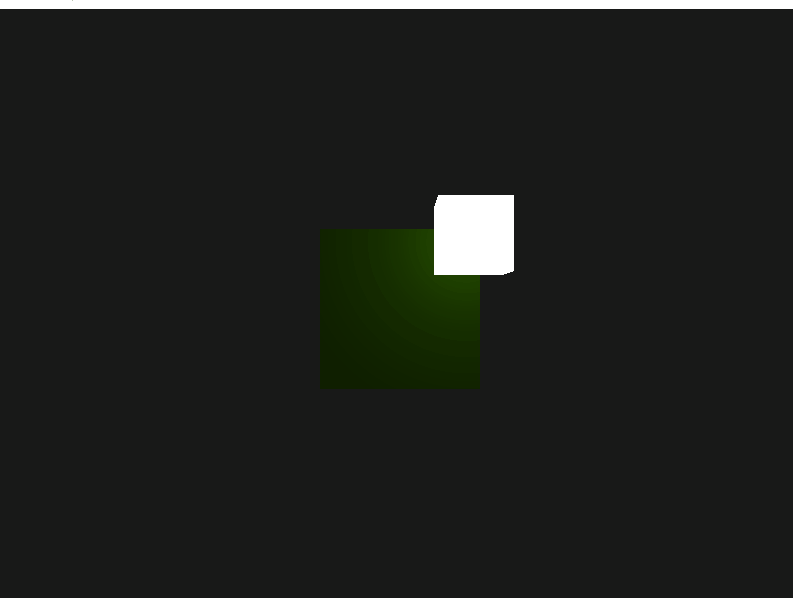
光照贴图
纹理与贴图关系
事实上,纹理与贴图原理是一样的,贴图也叫纹理贴图,其实都是使用一张覆盖物体的图像,让我们能够逐片段索引其独立的颜色值。
漫反射贴图
只是在光照场景中,它通常叫做一个漫反射贴图(Diffuse Map)(3D艺术家通常都这么叫它),它是一个表现了物体所有的漫反射颜色的纹理图像。
在着色器中使用漫反射贴图的方法和纹理教程中是完全一样的。
但这次我们会将纹理储存为Material结构体中的一个sampler2D。我们将之前定义的vec3漫反射颜色向量替换为漫反射贴图:
struct Material {
sampler2D diffuse;
vec3 specular;
float shininess;
};
...
in vec2 TexCoords;
注意sampler2D是所谓的不透明类型(Opaque Type),也就是说我们不能将它实例化,只能通过uniform来定义它。如果我们使用除uniform以外的方法(比如函数的参数)实例化这个结构体,GLSL会抛出一些奇怪的错误。这同样也适用于任何封装了不透明类型的结构体。
然后,我们将在片段着色器中再次需要纹理坐标,所以我们声明一个额外的输入变量。接下来我们只需要从纹理中采样片段的漫反射颜色值即可:
vec3 diffuse = light.diffuse * diff * vec3(texture(material.diffuse, TexCoords));
将环境光的材质颜色设置为漫反射材质颜色同样的值:
vec3 ambient = light.ambient * vec3(texture(material.diffuse, TexCoords));
脚本实现
创建顶点着色器和片元着色器
lighting_maps.vs
#version 330 core
layout (location = 0) in vec3 aPos;
layout (location = 1) in vec3 aNormal;
layout (location = 2) in vec2 aTexCoords;
out vec3 FragPos;
out vec3 Normal;
out vec2 TexCoords;
uniform mat4 model;
uniform mat4 view;
uniform mat4 projection;
void main()
{
FragPos = vec3(model * vec4(aPos, 1.0));
Normal = mat3(transpose(inverse(model))) * aNormal;
TexCoords = aTexCoords;
gl_Position = projection * view * vec4(FragPos, 1.0);
}
lighting_maps.fs
#version 330 core
out vec4 FragColor;
struct Material {
sampler2D diffuse;
vec3 specular;
float shininess;
};
struct Light {
vec3 position;
vec3 ambient;
vec3 diffuse;
vec3 specular;
};
in vec3 FragPos;
in vec3 Normal;
in vec2 TexCoords;
uniform vec3 viewPos;
uniform Material material;
uniform Light light;
void main()
{
// ambient
vec3 ambient = light.ambient * texture(material.diffuse, TexCoords).rgb;
// diffuse
vec3 norm = normalize(Normal);
vec3 lightDir = normalize(light.position - FragPos);
float diff = max(dot(norm, lightDir), 0.0);
vec3 diffuse = light.diffuse * diff * texture(material.diffuse, TexCoords).rgb;
// specular
vec3 viewDir = normalize(viewPos - FragPos);
vec3 reflectDir = reflect(-lightDir, norm);
float spec = pow(max(dot(viewDir, reflectDir), 0.0), material.shininess);
vec3 specular = light.specular * (spec * material.specular);
vec3 result = ambient + diffuse + specular;
FragColor = vec4(result, 1.0);
}
完整源码
#include <glad/glad.h>
#include <GLFW/glfw3.h>
#include <glm/glm.hpp>
#include <glm/gtc/matrix_transform.hpp>
#include <glm/gtc/type_ptr.hpp>
#define STB_IMAGE_IMPLEMENTATION
#include <stb_image.h>
// https://learnopengl.com/code_viewer_gh.php?code=includes/learnopengl/shader_m.h
#include <shader_s.h>
// https://learnopengl.com/code_viewer_gh.php?code=includes/learnopengl/camera.h
#include <camera.h>
#include <iostream>
void InitGLFW();
bool CreateWindow();
bool InitGLAD();
// 窗口大小改变时调用
void framebuffer_size_callback(GLFWwindow *window, int width, int height);
void mouse_callback(GLFWwindow *window, double xposIn, double yposIn);
void scroll_callback(GLFWwindow *window, double xoffset, double yoffset);
void processInput(GLFWwindow *window);
unsigned int loadTexture(const char *path);
// settings 窗口宽高
const unsigned int SCR_WIDTH = 800;
const unsigned int SCR_HEIGHT = 600;
// 相机
Camera camera(glm::vec3(0.0f, 0.0f, 6.0f));
float lastX = static_cast<float>(SCR_WIDTH) / 2.0;
float lastY = static_cast<float>(SCR_HEIGHT) / 2.0;
bool firstMouse = true;
// timing
float deltaTime = 0.0f; // time between current frame and last frame
float lastFrame = 0.0f;
// lighting
glm::vec3 lightPos(0.5f, 0.5f, 1.0f);
GLFWwindow *window;
int main()
{
InitGLFW(); // 初始化GLFW
bool isCreated = CreateWindow(); // 创建一个窗口对象
if (!isCreated)
return -1;
bool isGLAD = InitGLAD(); // 初始化GLAD,传入加载系统相关opengl函数指针的函数
if (!isGLAD)
return -1;
// 启用深度测试
glEnable(GL_DEPTH_TEST);
// 构建和编译着色程序
Shader lightingShader("shader/P1_Basic/08_LightModel/lighting_maps.vs", "shader/P1_Basic/08_LightModel/lighting_maps.fs");
Shader lightCubeShader("shader/P1_Basic/08_LightModel/light_mrt_cube.vs", "shader/P1_Basic/08_LightModel/light_mrt_cube.fs");
// 设置顶点数据(和缓冲区)并配置顶点属性
// 1.设置立方体顶点输入 一共需要36个顶点
float vertices[] = {
// positions // normals // texture coords
-0.5f, -0.5f, -0.5f, 0.0f, 0.0f, -1.0f, 0.0f, 0.0f,
0.5f, -0.5f, -0.5f, 0.0f, 0.0f, -1.0f, 1.0f, 0.0f,
0.5f, 0.5f, -0.5f, 0.0f, 0.0f, -1.0f, 1.0f, 1.0f,
0.5f, 0.5f, -0.5f, 0.0f, 0.0f, -1.0f, 1.0f, 1.0f,
-0.5f, 0.5f, -0.5f, 0.0f, 0.0f, -1.0f, 0.0f, 1.0f,
-0.5f, -0.5f, -0.5f, 0.0f, 0.0f, -1.0f, 0.0f, 0.0f,
-0.5f, -0.5f, 0.5f, 0.0f, 0.0f, 1.0f, 0.0f, 0.0f,
0.5f, -0.5f, 0.5f, 0.0f, 0.0f, 1.0f, 1.0f, 0.0f,
0.5f, 0.5f, 0.5f, 0.0f, 0.0f, 1.0f, 1.0f, 1.0f,
0.5f, 0.5f, 0.5f, 0.0f, 0.0f, 1.0f, 1.0f, 1.0f,
-0.5f, 0.5f, 0.5f, 0.0f, 0.0f, 1.0f, 0.0f, 1.0f,
-0.5f, -0.5f, 0.5f, 0.0f, 0.0f, 1.0f, 0.0f, 0.0f,
-0.5f, 0.5f, 0.5f, -1.0f, 0.0f, 0.0f, 1.0f, 0.0f,
-0.5f, 0.5f, -0.5f, -1.0f, 0.0f, 0.0f, 1.0f, 1.0f,
-0.5f, -0.5f, -0.5f, -1.0f, 0.0f, 0.0f, 0.0f, 1.0f,
-0.5f, -0.5f, -0.5f, -1.0f, 0.0f, 0.0f, 0.0f, 1.0f,
-0.5f, -0.5f, 0.5f, -1.0f, 0.0f, 0.0f, 0.0f, 0.0f,
-0.5f, 0.5f, 0.5f, -1.0f, 0.0f, 0.0f, 1.0f, 0.0f,
0.5f, 0.5f, 0.5f, 1.0f, 0.0f, 0.0f, 1.0f, 0.0f,
0.5f, 0.5f, -0.5f, 1.0f, 0.0f, 0.0f, 1.0f, 1.0f,
0.5f, -0.5f, -0.5f, 1.0f, 0.0f, 0.0f, 0.0f, 1.0f,
0.5f, -0.5f, -0.5f, 1.0f, 0.0f, 0.0f, 0.0f, 1.0f,
0.5f, -0.5f, 0.5f, 1.0f, 0.0f, 0.0f, 0.0f, 0.0f,
0.5f, 0.5f, 0.5f, 1.0f, 0.0f, 0.0f, 1.0f, 0.0f,
-0.5f, -0.5f, -0.5f, 0.0f, -1.0f, 0.0f, 0.0f, 1.0f,
0.5f, -0.5f, -0.5f, 0.0f, -1.0f, 0.0f, 1.0f, 1.0f,
0.5f, -0.5f, 0.5f, 0.0f, -1.0f, 0.0f, 1.0f, 0.0f,
0.5f, -0.5f, 0.5f, 0.0f, -1.0f, 0.0f, 1.0f, 0.0f,
-0.5f, -0.5f, 0.5f, 0.0f, -1.0f, 0.0f, 0.0f, 0.0f,
-0.5f, -0.5f, -0.5f, 0.0f, -1.0f, 0.0f, 0.0f, 1.0f,
-0.5f, 0.5f, -0.5f, 0.0f, 1.0f, 0.0f, 0.0f, 1.0f,
0.5f, 0.5f, -0.5f, 0.0f, 1.0f, 0.0f, 1.0f, 1.0f,
0.5f, 0.5f, 0.5f, 0.0f, 1.0f, 0.0f, 1.0f, 0.0f,
0.5f, 0.5f, 0.5f, 0.0f, 1.0f, 0.0f, 1.0f, 0.0f,
-0.5f, 0.5f, 0.5f, 0.0f, 1.0f, 0.0f, 0.0f, 0.0f,
-0.5f, 0.5f, -0.5f, 0.0f, 1.0f, 0.0f, 0.0f, 1.0f};
// 2.设置索引缓冲对象
unsigned int VBO, cubeVAO;
glGenVertexArrays(1, &cubeVAO);
glGenBuffers(1, &VBO);
glBindBuffer(GL_ARRAY_BUFFER, VBO);
glBufferData(GL_ARRAY_BUFFER, sizeof(vertices), vertices, GL_STATIC_DRAW);
glBindVertexArray(cubeVAO);
glVertexAttribPointer(0, 3, GL_FLOAT, GL_FALSE, 8 * sizeof(float), (void *)0);
glEnableVertexAttribArray(0);
glVertexAttribPointer(1, 3, GL_FLOAT, GL_FALSE, 8 * sizeof(float), (void *)(3 * sizeof(float)));
glEnableVertexAttribArray(1);
glVertexAttribPointer(2, 2, GL_FLOAT, GL_FALSE, 8 * sizeof(float), (void *)(6 * sizeof(float)));
glEnableVertexAttribArray(2);
// second, configure the light's VAO (VBO stays the same; the vertices are the same for the light object which is also a 3D cube)
unsigned int lightCubeVAO;
glGenVertexArrays(1, &lightCubeVAO);
glBindVertexArray(lightCubeVAO);
glBindBuffer(GL_ARRAY_BUFFER, VBO);
// note that we update the lamp's position attribute's stride to reflect the updated buffer data
glVertexAttribPointer(0, 3, GL_FLOAT, GL_FALSE, 8 * sizeof(float), (void *)0);
glEnableVertexAttribArray(0);
// 加载纹理
https://learnopengl-cn.github.io/img/02/04/container2.png
unsigned int diffuseMap = loadTexture("image/04_Textures/container2.png");
// shader configuration
// --------------------
lightingShader.use();
lightingShader.setInt("material.diffuse", 0);
// 循环渲染
while (!glfwWindowShouldClose(window))
{
// 计算帧间隔时间
float currentFrame = static_cast<float>(glfwGetTime());
deltaTime = currentFrame - lastFrame;
lastFrame = currentFrame;
// 输入
processInput(window);
// 渲染
// 清除颜色缓冲
glClearColor(0.1f, 0.1f, 0.1f, 1.0f);
// 清除深度缓冲
glClear(GL_COLOR_BUFFER_BIT | GL_DEPTH_BUFFER_BIT);
// be sure to activate shader when setting uniforms/drawing objects
lightingShader.use();
lightingShader.setVec3("light.position", lightPos);
lightingShader.setVec3("viewPos", camera.Position);
// light properties
lightingShader.setVec3("light.ambient", 0.2f, 0.2f, 0.2f);
lightingShader.setVec3("light.diffuse", 0.5f, 0.5f, 0.5f);
lightingShader.setVec3("light.specular", 1.0f, 1.0f, 1.0f);
// material properties
lightingShader.setVec3("material.specular", 0.5f, 0.5f, 0.5f);
lightingShader.setFloat("material.shininess", 64.0f);
// view/projection transformations
glm::mat4 projection = glm::perspective(glm::radians(camera.Zoom), (float)SCR_WIDTH / (float)SCR_HEIGHT, 0.1f, 100.0f);
glm::mat4 view = camera.GetViewMatrix();
lightingShader.setMat4("projection", projection);
lightingShader.setMat4("view", view);
// world transformation
glm::mat4 model = glm::mat4(1.0f);
lightingShader.setMat4("model", model);
// bind diffuse map
glActiveTexture(GL_TEXTURE0);
glBindTexture(GL_TEXTURE_2D, diffuseMap);
// render the cube
glBindVertexArray(cubeVAO);
glDrawArrays(GL_TRIANGLES, 0, 36);
// also draw the lamp object
lightCubeShader.use();
lightCubeShader.setMat4("projection", projection);
lightCubeShader.setMat4("view", view);
model = glm::mat4(1.0f);
model = glm::translate(model, lightPos);
model = glm::scale(model, glm::vec3(0.4f)); // a smaller cube
lightCubeShader.setMat4("model", model);
glBindVertexArray(lightCubeVAO);
glDrawArrays(GL_TRIANGLES, 0, 36);
// 检查并调用事件,交换缓冲
glfwSwapBuffers(window);
glfwPollEvents();
}
// 可选:一旦资源超出其用途,就取消分配所有资源:
glDeleteVertexArrays(1, &cubeVAO);
glDeleteVertexArrays(1, &lightCubeVAO);
glDeleteBuffers(1, &VBO);
// 释放/删除之前的分配的所有资源
glfwTerminate();
return 0;
}
void InitGLFW()
{
// 初始化GLFW
glfwInit();
// 配置GLFW 第一个参数代表选项的名称,我们可以从很多以GLFW_开头的枚举值中选择;
// 第二个参数接受一个整型,用来设置这个选项的值。
glfwWindowHint(GLFW_CONTEXT_VERSION_MAJOR, 3);
glfwWindowHint(GLFW_CONTEXT_VERSION_MINOR, 3);
glfwWindowHint(GLFW_OPENGL_PROFILE, GLFW_OPENGL_CORE_PROFILE);
// glfwWindowHint(GLFW_OPENGL_FORWARD_COMPAT, GL_TRUE);
}
bool CreateWindow()
{
// 创建一个窗口对象
window = glfwCreateWindow(800, 600, "LearnOpenGL", NULL, NULL);
if (window == NULL)
{
std::cout << "Failed to create GLFW window" << std::endl;
// 创建失败,终止程序
glfwTerminate();
return false;
}
// 将我们窗口的上下文设置为当前线程的主上下文
glfwMakeContextCurrent(window);
// 设置窗口大小改变时的回调函数
glfwSetFramebufferSizeCallback(window, framebuffer_size_callback);
// 设置鼠标移动回调函数
glfwSetCursorPosCallback(window, mouse_callback);
// 设置滚轮滚动回调函数
glfwSetScrollCallback(window, scroll_callback);
// 隐藏并捕捉鼠标
// glfwSetInputMode(window, GLFW_CURSOR, GLFW_CURSOR_DISABLED);
return true;
}
bool InitGLAD()
{
// 初始化GLAD,传入加载系统相关opengl函数指针的函数
if (!gladLoadGLLoader((GLADloadproc)glfwGetProcAddress))
{
std::cout << "Failed to initialize GLAD" << std::endl;
// 初始化失败,终止程序
return false;
}
return true;
}
// 窗口大小改变时调用
void framebuffer_size_callback(GLFWwindow *window, int width, int height)
{
// 设置窗口的维度
glViewport(0, 0, width, height);
}
// 输入
void processInput(GLFWwindow *window)
{
// 当用户按下esc键,我们设置window窗口的windowShouldClose属性为true
// 关闭应用程序
if (glfwGetKey(window, GLFW_KEY_ESCAPE) == GLFW_PRESS)
glfwSetWindowShouldClose(window, true);
if (glfwGetKey(window, GLFW_KEY_W) == GLFW_PRESS)
camera.ProcessKeyboard(FORWARD, deltaTime);
if (glfwGetKey(window, GLFW_KEY_S) == GLFW_PRESS)
camera.ProcessKeyboard(BACKWARD, deltaTime);
if (glfwGetKey(window, GLFW_KEY_A) == GLFW_PRESS)
camera.ProcessKeyboard(LEFT, deltaTime);
if (glfwGetKey(window, GLFW_KEY_D) == GLFW_PRESS)
camera.ProcessKeyboard(RIGHT, deltaTime);
}
// 鼠标移动回调函数
void mouse_callback(GLFWwindow *window, double xposIn, double yposIn)
{
// 长按T键,鼠标才能控制相机
if (glfwGetKey(window, GLFW_KEY_1) != GLFW_PRESS)
return;
float xpos = static_cast<float>(xposIn);
float ypos = static_cast<float>(yposIn);
if (firstMouse)
{
lastX = xpos;
lastY = ypos;
firstMouse = false;
}
float xoffset = xpos - lastX;
float yoffset = lastY - ypos; // reversed since y-coordinates go from bottom to top
lastX = xpos;
lastY = ypos;
camera.ProcessMouseMovement(xoffset, yoffset);
}
// 鼠标滚轮滚动回调函数
void scroll_callback(GLFWwindow *window, double xoffset, double yoffset)
{
camera.ProcessMouseScroll(static_cast<float>(yoffset));
}
unsigned int loadTexture(char const *path)
{
unsigned int textureID;
glGenTextures(1, &textureID);
int width, height, nrComponents;
unsigned char *data = stbi_load(path, &width, &height, &nrComponents, 0);
if (data)
{
GLenum format;
if (nrComponents == 1)
format = GL_RED;
else if (nrComponents == 3)
format = GL_RGB;
else if (nrComponents == 4)
format = GL_RGBA;
glBindTexture(GL_TEXTURE_2D, textureID);
glTexImage2D(GL_TEXTURE_2D, 0, format, width, height, 0, format, GL_UNSIGNED_BYTE, data);
glGenerateMipmap(GL_TEXTURE_2D);
glTexParameteri(GL_TEXTURE_2D, GL_TEXTURE_WRAP_S, GL_REPEAT);
glTexParameteri(GL_TEXTURE_2D, GL_TEXTURE_WRAP_T, GL_REPEAT);
glTexParameteri(GL_TEXTURE_2D, GL_TEXTURE_MIN_FILTER, GL_LINEAR_MIPMAP_LINEAR);
glTexParameteri(GL_TEXTURE_2D, GL_TEXTURE_MAG_FILTER, GL_LINEAR);
stbi_image_free(data);
}
else
{
std::cout << "Texture failed to load at path: " << path << std::endl;
stbi_image_free(data);
}
return textureID;
}
运行效果 :

高光反射贴图
我们同样可以使用一个专门用于镜面高光的纹理贴图。这也就意味着我们需要生成一个黑白的(如果你想得话也可以是彩色的)纹理,来定义物体每部分的镜面光强度。
镜面高光的强度可以通过图像每个像素的亮度来获取。镜面光贴图上的每个像素都可以由一个颜色向量来表示,比如说黑色代表颜色向量vec3(0.0),灰色代表颜色向量vec3(0.5)。
在片段着色器中,我们接下来会取样对应的颜色值并将它乘以光源的镜面强度。一个像素越「白」,乘积就会越大,物体的镜面光分量就会越亮。
从实际角度来说,木头其实也有镜面高光,尽管它的反光度(Shininess)很小(更多的光被散射),影响也比较小,但是为了教学目的,我们可以假设木头不会对镜面光有任何反应。
采样镜面光贴图
创建片段着色器的材质属性,让其接受一个sampler2D而不是vec3作为镜面光分量:
struct Material {
sampler2D diffuse;
sampler2D specular;
float shininess;
};
然后,通过采样镜面光贴图,来获取片段所对应的镜面光强度:
vec3 ambient = light.ambient * vec3(texture(material.diffuse, TexCoords));
vec3 diffuse = light.diffuse * diff * vec3(texture(material.diffuse, TexCoords));
vec3 specular = light.specular * spec * vec3(texture(material.specular, TexCoords));
FragColor = vec4(ambient + diffuse + specular, 1.0);
脚本实现
我们只创建片元着色器,顶点着色器和上面漫反射一样的,源码也类似
源码
...
// 加载纹理
// https://learnopengl-cn.github.io/img/02/04/container2.png
unsigned int diffuseMap = loadTexture("image/04_Textures/container2.png");
// https://learnopengl-cn.github.io/img/02/04/container2_specular.png
unsigned int specularMap = loadTexture("image/04_Textures/container2_specular.png");
...
// 循环渲染
while (!glfwWindowShouldClose(window)){
...
// bind diffuse map
glActiveTexture(GL_TEXTURE0);
glBindTexture(GL_TEXTURE_2D, diffuseMap);
// bind specular map
glActiveTexture(GL_TEXTURE1);
glBindTexture(GL_TEXTURE_2D, specularMap);
...
}
lighting_specular_maps.fs
#version 330 core
out vec4 FragColor;
struct Material {
sampler2D diffuse;
sampler2D specular;
float shininess;
};
struct Light {
vec3 position;
vec3 ambient;
vec3 diffuse;
vec3 specular;
};
in vec3 FragPos;
in vec3 Normal;
in vec2 TexCoords;
uniform vec3 viewPos;
uniform Material material;
uniform Light light;
void main()
{
// ambient
vec3 ambient = light.ambient * texture(material.diffuse, TexCoords).rgb;
// diffuse
vec3 norm = normalize(Normal);
vec3 lightDir = normalize(light.position - FragPos);
float diff = max(dot(norm, lightDir), 0.0);
vec3 diffuse = light.diffuse * diff * texture(material.diffuse, TexCoords).rgb;
// specular
vec3 viewDir = normalize(viewPos - FragPos);
vec3 reflectDir = reflect(-lightDir, norm);
float spec = pow(max(dot(viewDir, reflectDir), 0.0), material.shininess);
vec3 specular = light.specular * spec * texture(material.specular, TexCoords).rgb;
vec3 result = ambient + diffuse + specular;
FragColor = vec4(result, 1.0);
}
运行效果:
